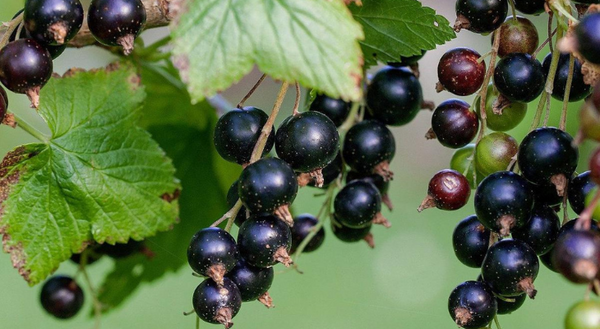
With the end of winter near, it’s time to start planning for the garden season. At the outbreak of COVID-19 last year, many people attempted to grow some of their own food, re-popularizing the concept of WWII “victory gardens.” Increase your victory garden growing capacity by planting some black currant bushes this March!
What is a black currant, you ask? It is a woody perennial fruit-bearing shrub, native to central and northern Europe; it produces delicious, nutritious and very visually appealing berries that are similar in size and shape to blueberries, with an intense blue-black color that gives it its name. The berries grow in tantalizing clumps on the canes of the black currant bush, which ripen in June and are ready for harvest by early July in our growing area. The flavor profile of the black currant has been described as concentrated blackberry, citrus fruit, pine, black pepper, anise, herbaceous and floral! What a mix!
Most of the global black currant production occurs in European countries, both commercially and domestically. However, currant plants thrive in fertile, wet soils and prefer cool winters. They also have an established tolerance to partial shade. Given decent soil, sufficient summer irrigation, and some annual pruning, they can produce an excellent crop. These characteristics and others make them an ideal addition to the home gardens and specialty crop production fields of the Upper Midwest.
Common commercial black currant products abroad are juice, jams, jellies, preserves, marinades, wines, alcohols and dyes, though for the most part they are grown for the commercial juice or fresh berry eating. Be sure to do your cultivar research before planting. Several varieties are higher in antioxidants than others, but very tart. For example, “Consort”, very high in antioxidants and other healthy compounds, is also extremely tart and makes a good “value-added” currant, whereas “Blackcomb” is a more palatable and less tart fresh-eating currant.
As mentioned, consuming black currants is good for you; in fact, they are a confirmed superfood. They have more antioxidants than blueberries, more vitamin C than oranges, and they have the most zinc of any fruit or vegetable you can eat. Health food stores in our area began carrying items like K.W. Knudsen’s Just Black Currant juice in the last few years, owing to black currant’s prolific health benefits.
On the other end of the health spectrum, black currant is becoming a popular ingredient in the craft brewing world, owing to interesting and complex flavors that can result from its fermentation. Three Central Illinois breweries (at least), as well as their customers, have some experience with this. Destihl Brewing in Bloomington, Blind Pig Brewery in Champaign and Big Thorn Brewing in Georgetown, IL have all recently brewed beers featuring black currant. Several larger craft breweries throughout the US feature it in their brews as well. There are sure to be more economic opportunities for black currant growers and artisan makers on the horizon in the alcohol business, but also far beyond. To see what all the fuss is about, contact your local extension office to discuss good sources of nursery stock, or be on the look-out this year for fresh berries and specialty black currant products at farmers markets or health food stores.